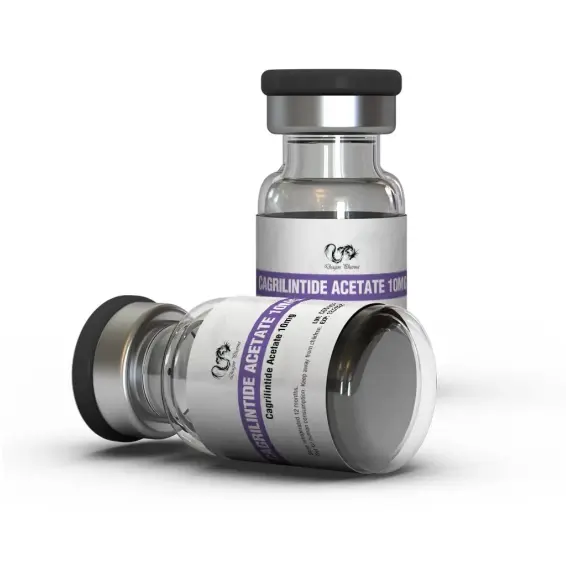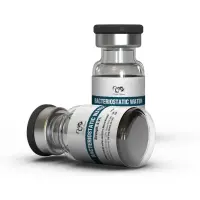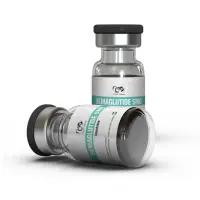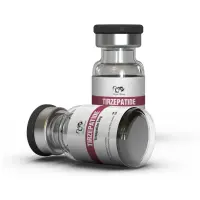- Manufacturer: Dragon Pharma
- Substance: Cagrilintide
- Dosage: 10 mg
- Form:Injection
- Packing: vial
- Brand Name: Cagrilintide
Shipping From
Cagrilintide by Dragon Pharma is a high-potency peptide containing 10 mg of Cagrilintide, a synthetic amylin analog designed to promote significant weight loss and improve glycemic control. Targeting the amylin pathway, it regulates appetite, slows gastric emptying, and enhances satiety, making it a powerful tool for managing obesity and type 2 diabetes. With clinical trials showing up to 10.8% weight loss in 26 weeks, Cagrilintide offers a modern approach to metabolic health, especially when paired with GLP-1 agonists like semaglutide.
What It Is Cagrilintide
Cagrilintide is a long-acting amylin analog that mimics the pancreatic hormone amylin, co-secreted with insulin to regulate appetite and glucose metabolism. Unlike GLP-1 agonists like semaglutide or tirzepatide, it targets amylin receptors in the brain (e.g., area postrema, nucleus tractus solitarius), offering a complementary mechanism for weight loss and glycemic control. Administered via weekly subcutaneous injections, it's under investigation for obesity and type 2 diabetes management.
How It Works
Cagrilintide activates amylin receptors to slow gastric emptying, suppress glucagon secretion, and enhance satiety, reducing food intake and stabilizing blood sugar. This leads to significant weight loss by targeting visceral fat and curbing hunger. When combined with GLP-1 agonists, its synergistic effects amplify weight loss, achieving up to 17–20% body weight reduction in trials, surpassing semaglutide alone and rivaling tirzepatide. Its long half-life supports once-weekly dosing for convenience.
Cagrilintide Benefits
- Significant Weight Loss: Up to 10.8% body weight reduction in 26 weeks; 17–20% when combined with semaglutide.
- Appetite Control: Sustained satiety reduces cravings and overeating.
- Glycemic Stability: Lowers HbA1c by 0.8–1.2% alone, up to 2.0% with semaglutide.
- Cardiometabolic Health: Modest improvements in triglycerides and blood pressure.
- Tolerability: Lower incidence of nausea and vomiting compared to GLP-1 agonists.
Who It's For
Cagrilintide is ideal for men and women aged 20–40 with obesity (BMI ≥30 kg/m²) or type 2 diabetes, particularly those seeking significant weight loss and better metabolic control. It suits recreational gym-goers and athletes focused on body recomposition. Not for: Pregnant or nursing women, individuals under 18, or those with uncontrolled medical conditions. Use under medical supervision or research protocols is critical.
How to Use Cagrilintide
Dosage: Typical dosages range from 0.6–2.4 mg/week, administered via subcutaneous injection. Start with 0.6 mg/week and titrate up to 2.4 mg/week over 4–8 weeks to minimize side effects. Cycles typically last 20–32 weeks, based on clinical trial protocols.
Administration: Reconstitute the 10 mg vial with 1–2 ml Bacteriostatic Water. Inject subcutaneously into fatty areas (e.g., abdomen, thigh) once weekly, using sterile techniques. Rotate injection sites to avoid irritation.
Results Timeline: Weight loss and glycemic improvements may begin within 4–6 weeks, with significant results (6–10.8%) by 26 weeks. Combination with semaglutide can yield up to 17% weight loss by 20–32 weeks.
Stacking Suggestions
Cagrilintide shines in combination with GLP-1 agonists but can be used alone:
- Weight Loss Stack: Combine with Semaglutide (2.4 mg/week) for up to 17–20% weight loss (CagriSema).
- Metabolic Stack: Pair with Tirzepatide (10–15 mg/week) for enhanced weight loss and glycemic control, though clinical data is limited.
- Lifestyle Support: Complement with a low-calorie, high-protein diet and regular exercise for optimal results.
Side Effects
Cagrilintide is generally well-tolerated, but potential side effects include:
- Gastrointestinal: Nausea, vomiting, and diarrhea (mild to moderate, less frequent than GLP-1 agonists).
- Injection-Site Reactions: Redness, swelling, or discomfort at the injection site.
- Fatigue: Mild tiredness reported in some users, though not a primary side effect.
- Hypoglycemia Risk: Low risk, but increased when combined with insulin or sulfonylureas.
Monitor for symptoms and adjust dosing under medical supervision. Fatigue is not consistently reported but may occur due to caloric reduction or metabolic changes.
Post Cycle Therapy (PCT)
Cagrilintide does not affect testosterone production or require PCT, as it's a non-hormonal peptide. Post-cycle, maintain a healthy diet and exercise to sustain weight loss and metabolic benefits. Regular monitoring of blood sugar and body composition is recommended.
Frequently Asked Questions
What is Cagrilintide?
Cagrilintide is a synthetic amylin analog that promotes weight loss and glycemic control by slowing gastric emptying, enhancing satiety, and suppressing glucagon secretion. It's under investigation for obesity and type 2 diabetes.
What is Cagrilintide for men?
For men, Cagrilintide supports significant weight loss (up to 10.8% in 26 weeks) and improves metabolic health, making it ideal for managing obesity or type 2 diabetes while maintaining muscle mass with proper diet and exercise.
How much Cagrilintide should I take?
Typical dosages range from 0.6–2.4 mg/week, injected subcutaneously. Start at 0.6 mg/week, titrating up to 2.4 mg/week over 4–8 weeks, based on medical guidance and tolerability.
Can you take Cagrilintide and Tirzepatide together?
While clinical trials are limited, combining Cagrilintide with Tirzepatide is under investigation for enhanced weight loss and glycemic control due to their complementary mechanisms. Consult a physician for safety and dosing.
Is Cagrilintide better than Tirzepatide?
Cagrilintide alone yields 6–10.8% weight loss, while Tirzepatide achieves 15–22%. Cagrilintide with Semaglutide (CagriSema) can match or exceed Tirzepatide's results (17–20%). Cagrilintide may have fewer gastrointestinal side effects.
Does Cagrilintide make you tired?
Fatigue is not a primary side effect, but mild tiredness may occur due to caloric reduction or metabolic changes. Clinical trials report nausea and injection-site reactions as more common. Monitor and consult a physician if persistent.



